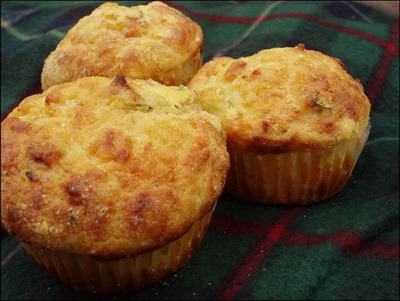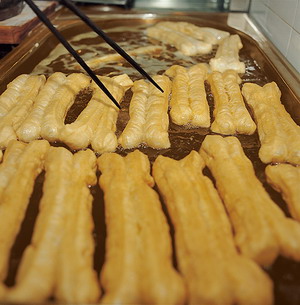
Published by the Centre for Food Safety
Feature Article
Green Muscle Disease
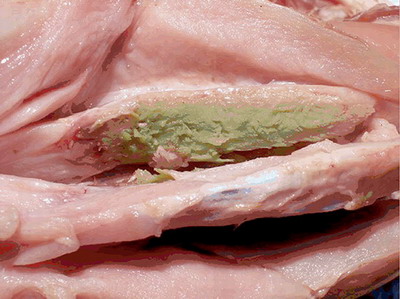
Green Muscle Disease (or Oregon Disease) is a common name given to a degenerative muscle disease known as Deep Pectoral Myopathy (DPM), a condition characterised by necrosis of the breast tender (pectoralis minor) muscles of poultry selected for meat production.
DPM develops more frequently in commercially raised broiler chickens as the chickens are kept relatively comfortable and inactive during the growing period. Consequently, the pectoral muscles are not exercised enough to increase efficiency of the circulatory supply to the muscles and to allow the expansion of the surrounding fibrous sheath. Therefore, a short period of sudden and excessive wing flap will cause rapid oxygen deficiency, lack of oxygen (ischaemic necrosis) of the muscle fibres and fall in muscle pH. Often, only the middle part of the breast fillet is involved , develop ing a lesion with progressive greening (as shown in the figure), which is in parallel with the loss of cellular structure and breakdown of h a emoglobin and myoglobin to bile salts.
Breast fillets and tenders are economically the most important muscles of poultry. Severe red, purple and green discoloration of broiler tenders is a frequent cause of trim and condemnation during the deboning process in the production plant. Hence, DPM causes significant economic loss in the poultry industry.
The key to reducing the incidence of DPM lies in proper management of the broiler flock and minimising wing flapping such as avoiding putting the birds under s tress, frightening the birds, catching the birds by their wings, as well as excessive light and human activity in the house.
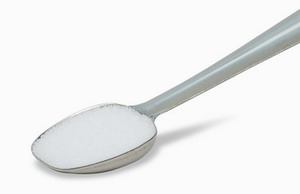
WHO recommends that the daily sodium intake for an adult should be less than 2 000 mg (i.e. approximately equal to 5 g or one level teaspoon of table salt).
Readers' Corner
Trade Guidelines for Reducing Sodium (Commonly Known As Salt), Sugars and Fats in Food Products
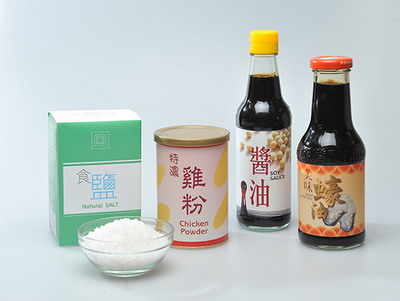
Sodium is naturally present not only in salt and seasonings, but also in foods (such as milk) and food additives in processed foods.
For Sodium / Salt:
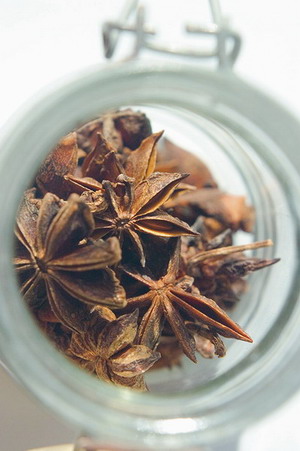
- Adhere to good manufacturing practice (GMP) when using salt containing seasonings, e.g. add the standardised amount as required in the cooking of food, and frequently use portable salt metres to gauge the amount of salt in non-prepackaged flavoured products such as soups and condiments. Aim to maintain suitable amount of salt in food products.
- Provide training or retraining to cooks, chefs and product developers to help them understand and accept healthy eating, as well as how to choose healthier products.
- Taking into account the characteristics of individual food products, adopt some of the proven strategies and replacements used in other countries to reduce the salt content of the products. For example, to extend the shelf-life of meat products, storage temperatures may be lowered to reduce or even replace the use of preservatives.
- Provide products with no or low salt, ( iodised salt as well if possible ) for customers to choose, or add salt and other seasonings only upon request of clients.
- Reduce the use of salt and ingredients which are high in salt . For example, using fresh, frozen or reduced-salt canned vegetables to replace pickles ; using fresh meat to replace cured or preserved meats ; or using natural ingredients to replace seasonings or sauces which are high in salt.
- Use natural ingredients (e.g. lemon, tomato) , herbs and spices (e.g. garlic, chilli, star anise, lemongrass, basil, etc.) for flavouring and marinating.
- Provide seasonings in separate packets and serve gravies in separate containers for customers' use according to their own preferences.
- Provide the customers with a wider choice of different portion sizes or smaller portion size of the products. If a smaller portion size cannot be provided , consider improving the storage method or packaging (e.g. using zipper bags and resealable containers) to facilitate the consumers in better storage of the leftover food for later consumption.
- Minimise the use of flavour enhancers / salt substitutes as far as possible.
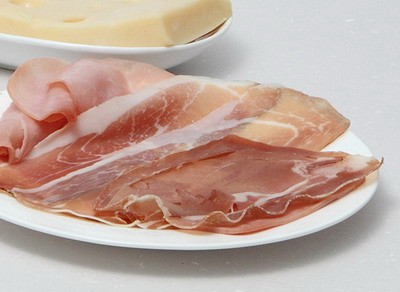
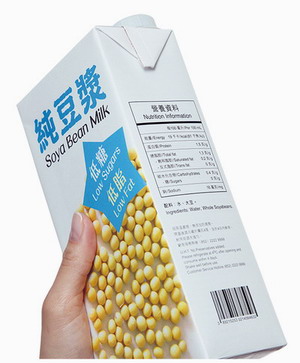
For Sugars and Fats:
- Adhere to GMP when using sugars and fats, with a view to meeting the sugars / fats reduction targets.
- Provide training or retraining to cooks, chefs and product developers to help them understand and accept healthy eating, as well as how to choose healthier food products.
- Develop products with low sugars and low fats content and use less food additives as far as possible. For example, when preparing meat pie, try to cut down on sugars and fats by choosing leaner meat for the filling and adjusting the ratio of fat and flour in the pastry.
- In designing low sugars and low fats recipes, pay attention not only to the sensory and textural properties, but also to the microbiological safety and stability of the products. To control the microbiological risk as a result of lowered sugar / fat levels in the products, consider alternatives to using preservatives such as reducing the pH value, lowering the storage temperature, lengthening the heat ing process and using packaging techniques (e.g. vacuum packing, nitrogen packing).
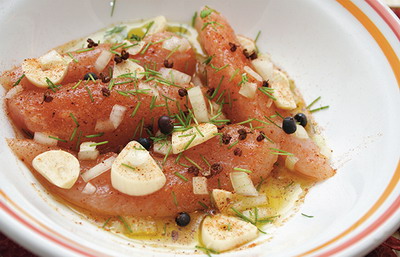 Provide customers with a choice of products with low sugars and low fats content.
Provide customers with a choice of products with low sugars and low fats content.- Serve sugar, syrup and spread or salad dressings separately for customers' use according to their own preferences.
- Provide customers with a wider choice of different portion sizes or smaller portion size of the products. If a smaller portion size cannot be provided , consider improving the storage method or packaging (e.g. using zipper bags and resealable containers) to facilitate the consumers in better storage of the leftover food for later consumption.
- Offer products that are low in fats, saturated fats and trans fats ; and dishes prepared by low fat cooking methods (e.g. steaming, grilling) rather than deep-frying.
- Use sugars and fats replacers only when necessary.
- Prepare foods for diabetes mellitus patients according to the latest scientific consensus. The composition of the foods should be in accordance with the requirements of low sugars , low fats and the dietary management of the patients.
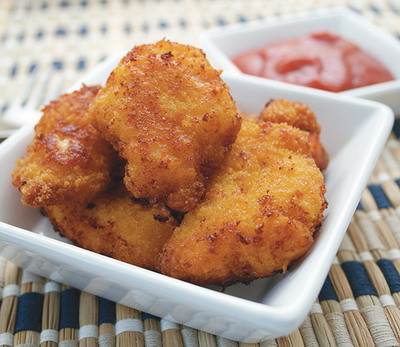


A Gentle Reminder – Food Safety Ordinance
The Food Safety Ordinance (Chapter 612) commenced its full operation on 1 February 2012. Any person who carries on a food business (including farmers, fishermen, hawkers and market stall lessees selling food) should note the relevant measures, which are mainly aimed at introducing a food tracing mechanism to help the Government trace the source of the food more effectively and take prompt action when dealing with food incidents. The food tracing mechanism includes a registration scheme for food importers and food distributors and a record-keeping requirement relating to movement of food. For details, please visit the website of the Centre for Food Safety (CFS) at www.cfs.gov.hk.
Handy Tips to Get the Temperature Right:
How to Cook Food Thoroughly
Food must be cooked with a core temperature of 75 ℃ or above for at least 30 seconds. For cooked meat and poultry, the juices in the meat should not be red and there should not be any traces of blood when the meat is cut. As for cooked eggs, the yolks should be firm. When cooking or reheating soups and stews, bring them to the boil and keep boiling for at least one minute.

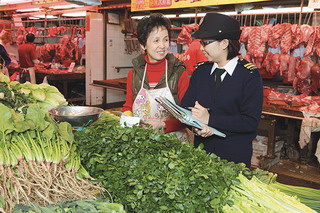
News on New Dishes
Delicious and Healthy – Assorted Seafood with Thousand Layer Bean Curd
Fresh and healthy ingredients complemented by the chef's superb knife skills give a powerful showcase of a colourful, aromatic and delicious dish – Assorted Seafood with Thousand Layer Bean Curd! In this issue, we are honoured to have invited Chef FUNG Kin-wai, head chef of New Star Seafood Restaurant, a signatory of the Food Safety Charter , to demonstrate how to prepare the dish.
| Preparation Steps | Small Tips, Big Wisdom | |
|---|---|---|
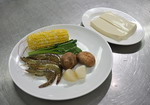 |
Receiving | First, purchase bean curd, shrimps, frozen scallops and other ingredients from approved and reliable sources. Upon receipt of the ingredients, check with meticulous care to ensure their freshness. Before use, ingredients such as bean curd and shrimps should be kept in a refrigerator at 4 ℃ or below while frozen scallops in a refrigerator at -18 ℃ or below. |
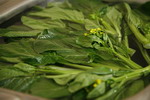 |
Rinsing | Vegetables (including fresh mushrooms) should be soaked and rinsed thoroughly. Soaking softens the mushrooms. This step not only prepares them for further handling, but also removes contaminants such as sand and mud effectively. |
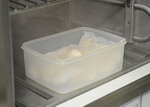 |
Defrosting | Defrost frozen scallops in a refrigerator at 4 ℃ or below. Defrosting in a refrigerator at 4 ℃ or below is not only safe but also keeps the fresh flavour of scallops. |
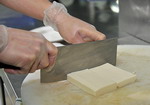 |
Cutting | Cut a block of bean curd into domino-shaped slices. Dice other ingredients: fresh shrimps (50 g), frozen scallops (50 g), fresh mushrooms (2 pieces) and Chinese flowering cabbage (1 piece). Remove corn kernels from the cob. Cutting bean curd into domino-shaped thin slices and other ingredients into dices shortens the cooking time and makes it easier to cook the bean curd and other ingredients thoroughly. |
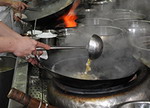 |
Blanching | Blanch diced shrimps, scallops, mushrooms and Chinese flowering cabbage as well as corn kernels in boiling water. Drain them dry when cooked and set aside. Blanching is a method of cooking which easily ensures that ingredients are cooked thoroughly and takes less time compared to stir-frying the raw ingredients. |
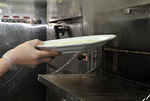 |
Steaming | Arrange the domino-shaped bean curd slices in a circular formation on a plate. Sprinkle salt on them and steam for 2 minutes. Pre-set the correct time and temperature for steaming. |
 |
Stir-frying | Heat oil in wok. Stir-fry the ingredients until fragrant and centre them in side the circle of bean curd slices. Brisk stir-frying in wok makes ingredients more delicious and ensures that they are cooked thoroughly. |
 |
Saucing | Add a small amount of water to wok. When water boils, add oyster sauce, salt, sugar, light soy sauce, dark soy sauce and cornflour to thicken the sauce. After bringing the thickened sauce to the boil, pour it onto the bean curd. Ready to serve. Bring the seasoning sauce to the boil before pouring it onto the bean curd. The food should be consumed immediately. |
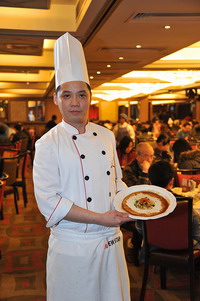
Tips from Chef FUNG:
- Preparation of bean curd must be done as quickly as possible . Otherwise, the bean curd will soon become dry and lack moisture, making it more difficult to spread out the bean curd slices like domino tiles. Moreover, steam the bean curd slices until yellowish water seeps out, then take them out and set aside. When small holes start to form on the bean curd surfaces, it is already overdone!
- Quality ingredients are the cornerstone of all tasty dishes. The restaurant will purchase ingredients from reputable and licensed suppliers. Orders are placed according to the estimated consumption of that day to ensure that fresh ingredients are used every day.
- Upon receipt of the ingredients and before cooking, the staff will thoroughly check whether there are any problems with the ingredients. If the ingredients are found to be damaged on their surfaces or giving out unpleasant smell etc, they will be discarded at once and the suppliers concerned will be informed of the problems.
- The restaurant has established a supervisory system to ensure cleanliness of food and environment. Various codes of hygiene and operational guidelines have been laid down for staff, who m is also provided with on-the-job training to make sure that they understand and comply with these codes and guidelines.
- Refrigerators are checked and their temperatures are recorded by staff every day. Moreover, regular maintenance of refrigerators is carried out to ensure that they are in good working order.
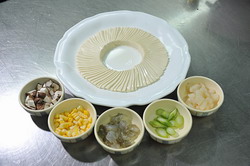
Food Safety Plan Corner
Assorted Seafood with Thousand Layer Bean Curd
Ingredients:
Fresh shrimps, frozen scallops, bean curd, fresh mushrooms, fresh corn on the cob and Chinese flowering cabbage
Seasoning:
Oyster sauce, salt, sugar, light soy sauce, dark soy sauce and cornflour
Method:
- Defrost frozen scallops in a refrigerator at 4 ℃ or below. Rinse the ingredients with water (soak the vegetables first).
- Dice shrimps, scallops, mushrooms and Chinese flowering cabbage, and remove corn kernels from the cob. Blanch all these ingredients in boiling water until cooked and set aside.
- Cut bean curd into domino-shaped slices and steam for 2 minutes.
- Return the blanched and cooked ingredients to the wok, and stir-fry until fragrant.
- Cook sauce with seasoning. Pour the thickened sauce onto the bean curd. Ready to serve.
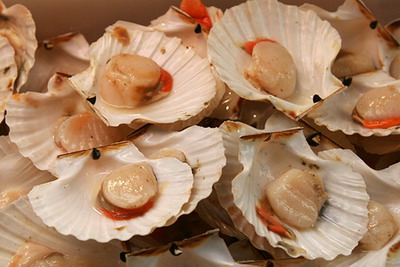
Production Process
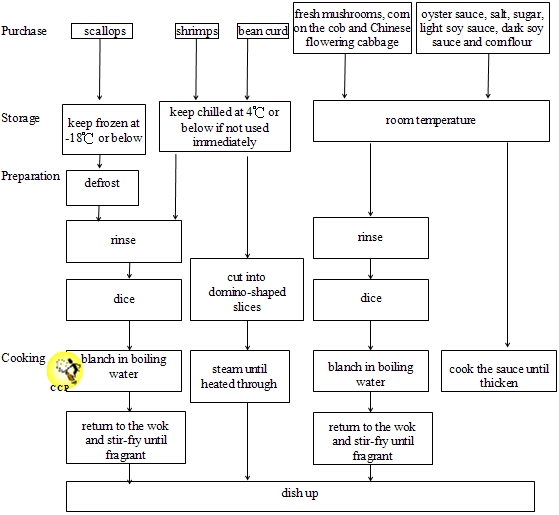
Critical Control Point (CCP)
It is a step or procedure in a food manufacture process at which control can be applied and as a result,
food safety hazard can be prevented or eliminated.
There is one Critical Control Point in the production of Assorted Seafood with Thousand Layer Bean Curd:
- Ingredients should be cooked thoroughly before consumption.
Food Safety Q&A
| Q: | Will our health be affected if we consume shellfish contaminated with heavy metals? |
|---|---|
| A: | Exposure to high level of mercury, especially organic mercury, can cause adverse effect on the nervous system. Chronic toxicity due to arsenic (inorganic arsenic is more toxic) may lead to nerve damage and diseases of the blood vessels. On the other hand, chronic toxicity due to cadmium may affect the kidneys.
Generally speaking, shellfish is one of the main dietary sources of cadmium and inorganic arsenic. Consuming food contaminated with heavy metals in trace amount usually will not significantly affect adults' health. Therefore, adults are unlikely to experience acute toxicity caused by heavy metals from normal diet. Of course, health may be affected if we consume shellfish with exceeding levels of heavy metals in a prolonged period of time. Maintaining a balanced diet is important to avoid excessive intake of contaminants. We should not eat too much shellfish. |
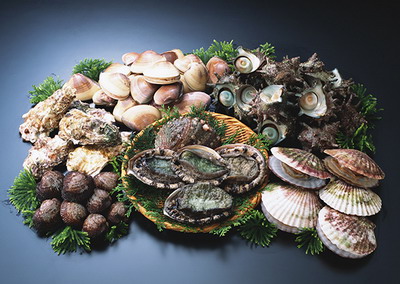
Advice to Trade
- Observe good agricultural and manufacturing practices to minimise metallic contamination of foods.
- Obtain food supplies only from reliable sources.
- Maintain proper food acquisition records to enable source tracing when required.
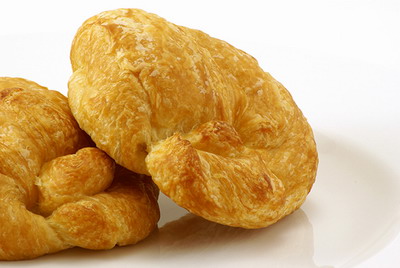
Truth against Fallacy
| Q: | Since margarine contains trans fats, which can raise the level of the "bad" cholesterol in blood, should we only eat butter? |
|---|---|
| A: |
Trans fats mainly come from hydrogenated vegetable oils used as ingredients in the production of food or in frying or baking. However , it should be noted that a low level of trans fats can also be found naturally in the milk and the fats (and their processed products including whole milk and butter) of some animals (sheep and cattle). Owing to the fact that the consumption of food containing trans fats can raise the level of the "bad" cholesterol (low-density lipoprotein (LDL)) while lower that of the "good" cholesterol (high-density lipoprotein (HDL)) in the human body, thus increasing the risk of coronary heart disease, many people opt for butter instead of margarine in their diet for the sake of health . But is this choice really healthier? In fact, butter is high in both saturated fats and cholesterol, which are not good for our heart health. On the contrary, most margarine is made from vegetable oils which are cholesterol-free and generally lower in saturated fats. When choosing butter products as ingredients, try to look for new formulations of margarine that have come to the market in recent years. They contain little amount of trans fats. Moreover, soft margarine generally ha s lower trans fats than the harder one. All in all, a balanced diet remains the key to good health. We should develop the good habit of avoiding high oil foods and animal fats / oils. Use as little fat / oil as possible in the preparation of food , and provide customers with more choices of low oil products.
|
Info Corner
Benzo[a]pyrene in Cooking Oil and Gutter Oil
Benzo[a]pyrene (B[a]P) is a kind of Polycyclic Aromatic Hydrocarbons (PAHs). PAHs are ubiquitous in the environment, being present in air, soil, water, sediment and food. Sources of B[a]P in foodstuffs include contaminated air, water, soil and sediment, and formation and deposition of B[a]P compounds during heating at high temperature s (e.g. roasting, smoking and grilling).
At present, it is not easy to identify cooking oil made from gutter oil or mixed cooking oils of poor quality simply by laboratory test. Nevertheless, test results could ascertain if the cooking oil contains excessive amount of harmful substances. The Codex Alimentarius Commission has not established standard for B[a]P in food. The standards for B[a]P in vegetable oil in the European Union and Mainland China are 2μg/kg and 10μg/kg respectively. The CFS has recently established a provisional action level of 10μg/kg for B[a]P in cooking oil.
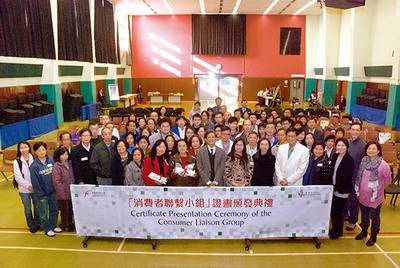
Briefing of Activities
Certificate Presentation Ceremony of the 4 th Term Consumer Liaison Group
The Consumer Liaison Group (CLG) provides a platform for better communication with the public on various food safety issues so as to collect suggestions and comments from them; and to understand the public's knowledge, beliefs and risk perception on various food safety issues in order to tailor risk communication messages to meet their needs.
The Certificate Presentation Ceremony of the 4 th term CLG was successfully held on the afternoon of 8 December 2012 at the Lai Chi Kok Government Offices.
At the ceremony, Dr HO Yuk-yin, Consultant (Community Medicine) (Risk Assessment and Communication) of the CFS gave a welcoming speech and thanked all CLG members for their active participation. Ms Melissa LIU, Scientific Officer of the CFS, then briefed members on the legislative proposals relating to formula products and foods intended for infants and young children in Hong Kong. Members raised questions and expressed views on the proposals. Lastly, Professor MA Ching-yung, Chairman of the Expert Committee on Food Safety, presented the certificates and took photos with members.
Upcoming Activities
Every year, the CFS organises trade talks and workshops on Hazard Analysis and Critical Control Point ( HACCP) to enhance the knowledge of food safety among trade members and to provide a platform for the communication between the Government and the food trade. The talks of this year are scheduled to be held from March to December at town halls and civic centres across the territory. They cover topics such as the Five Keys to Food Safety, HACCP and food-related legislation. Some of them will specifically focus on the handling of high-risk foods (e.g. sushi and sashimi). For details, please visit the CFS website (www.cfs.gov.hk) or call 2381 6096.
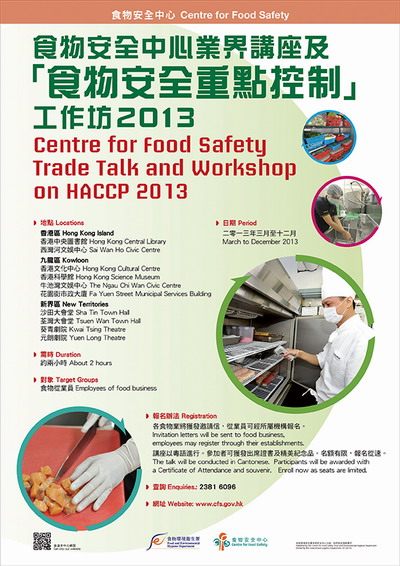
Brain Gym
Matching Game
| 1) Benzo[a]pyrene | (a) | Metabolites from moulds on improperly handled or stored food products (e.g. peanuts, maize, cereals, cottonseeds, tree nuts and some spices) in hot and humid tropical environments. |
|---|---|---|
| 2) Aflatoxins | (b) | Compounds uptake from polluted air by food crops or form ed in food during cooking at a high temperature s, such as roasting, smoking and grilling. |
| 3) Norovirus | (c) | A potent toxin often associated with the intake of pufferfish. Symptoms of intoxication include numbness sensation in the face and extremities, followed by progressive paralysis and respiratory distress. With high dose exposure, death may occur. |
| 4) Trans Fats | (d) | Mainly caused by using hydrogenated vegetable oil as a food ingredient or using it for frying and baking. |
| 5) Tetrodotoxin | (e) | Commonly found in shellfish, especially raw oysters, uncooked vegetables, salad and ice cubes. It can cause non-bacterial gastroenteritis in humans. |

Enquiry and Subscription
Printed copies of the Food Safety Express can be collected at the Communication Resource Unit located at 8/F, Fa Yuen Street Municipal Services Building, 123A Fa Yuen Street, Mong Kok, Kowloon. For enquiry, please call 2381 6096. The public may also visit the website of the CFS ( http://www.cfs.gov.hk) for the online version.
